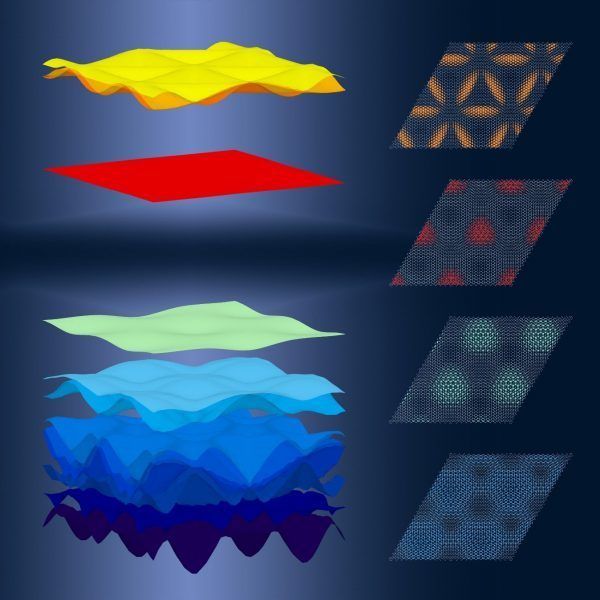Multiflat Bands and Strong Correlations in Twisted Bilayer Boron Nitride: Doping-Induced Correlated Insulator and Superconductor
An international team of researchers has for the first time demonstrated that twisted bilayer boron nitride (TBBN) is an even more exciting novel system that turns out to be an excellent platform to realize new correlated phases and phenomena. Exploration of its electronic properties shows that in contrast to twisted bilayer graphene in twisted bilayer BN multiple families of 2,4, and 6-fold degenerate flat bands emerge without the need to fine tune close to a “magic angle”. This results in dramatic and tunable changes in optical properties and exciton physics, and providing an additional platform to study strong correlations in low dimensional materials.
Twisted bilayer graphene has recently been identified as an intriguing novel system with potential high impact on fundamental as well as applied research. It is intensely debated because it could host unconventional topological superconductivity (a milestone towards the realization of universal quantum computing) as well as provide novel inroads to the long-standing problem of explaining the mechanism driving high-temperature superconductivity. The present work published in Nano Letters opens up a new route of research of phenomena linked to strongly electron correlations and new phases of matter in low dimensions considering different classes of 2D materials stacked at a twist, which the authors exemplify by performing large-scale numerical ab-initio investigations of twisted bilayer boron nitride. They find that, in contrast to twisted bilayer graphene, many multiple nearly degenerate at bands emerge for which correlations become very relevant. The results provided show that twisted bilayer boron nitride has many new key features that are highly desirable for future experiments and could open up entirely novel fields of research.

Atomic and electronic structures of twisted bilayer BN. Schematic illustration of the possible configurations in twisted bilayer hBN that have the same Moiré pattern. Showing the localization of electronic states in the flat bands.
First, due to the massive nature of the Dirac Hamiltonian governing boron nitride (in contrast to the massless nature of graphene) the appearance of at bands is not limited to the so-called “magic angles” as in twisted bilayer graphene. Not having to ne-tune the angle should increase the experimental accessibility considerably while still keeping the interesting feature of promoting correlation effects intact. Secondly, in twisted bilayer boron nitride three families of two-fold, three-fold and four-fold degenerate bands emerge, thus generalizing the two-fold degenerate case of twisted bilayer graphene, and potentially allowing even more complex band structures and thus phases of matter. The bands, with large effective masses and with charge distributions localized in specific sub-domains of the moire supercell are expected to modify the optical properties of insulating samples, in particular affecting the excitonic part of the spectrum in a drastic way. Thirdly, in doped or photo-doped samples, the authors demonstrate that the correlations at energies close to the two-fold degenerate at bands lead to physics much akin to that reported for twisted bilayer graphene. In addition, the different families of degenerate at bands can be probed in the same sample by simply varying the lying, thus expanding the novel physics discovered in graphene. This elevates twisted bilayer boron nitride to a prime candidate for future experimental studies.
The present work will spark many more experimental as well as theoretical studies in the novel realm of twisted bilayer materials, where the exploration of the possibilities of this emerging field is at its very beginning (at the crossroad of the fields of strong correlations, materials science, topology and quantum computing). The results reported here considerably broaden the viewpoint on this blossoming field of science, opening the door to similar work in other 2D twisted materials (that the authors are also pursuing).



